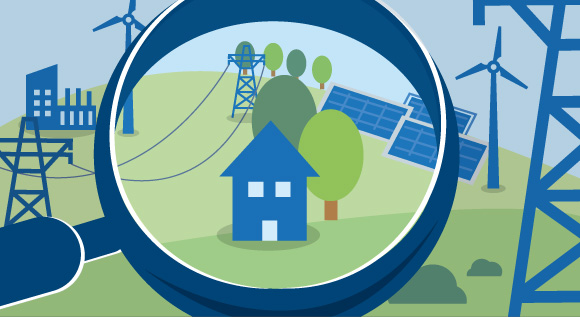What exactly is ‘balancing energy’?
The Bundesnetzagentur has adopted new rules that will make it easier for generators of renewable energy to provide balancing energy. But what exactly is balancing energy and what do the new rules mean? Read the following article to find out more.
 © BMWi
© BMWi
Balancing energy is all about stabilising the grid by ‘balancing’ energy supply and demand, and about how renewable energy can take on a more important role in this mechanism.
In order to keep a pair of scales in balance, both the left pan and right pan need to contain exactly the same mass. When you add weight to one pan or remove weight from it, you need to do the same for the other pan, otherwise the scales won’t be balanced.
The same principle applies to the way our electricity grid works: electricity generation and consumption need to be balanced at all times. In order to keep our grid stable, electricity generation needs to increase whenever electricity consumption rises. And if consumption goes down, electricity generation needs to be reduced.
When it comes to ensuring that the grid is stable, generation facilities such as wind farms, and consumers such as large industrial companies play a key role. In Germany, electricity generation facilities and consumers are organised in balancing groups. A balancing group is a virtual energy account that is managed by an ‘accountant’ – the balancing group manager. This manager predicts how much electricity will be generated and consumed within his balancing group (to find out more about balancing groups, please click here (information in German only)). But there are times when predictions fail. For example when a power plant suddenly goes offline, when there is no wind for turbines, or when there is an unexpected spike in electricity consumption. In these cases, there is either too much or too little electricity in the grid and the balancing group needs to regain its balance. This is where balancing energy comes in.
Three types of balancing energy
In order to increase or reduce the amount of electricity in the grid, the transmission system operators buy balancing energy from generation facilities that can provide electricity at short notice. In order for this to work well, the transmission system operators organise auctions in which facility operators are asked to place a bid for the amount of electricity they can provide or absorb from the grid at short notice in cases of emergency. Power plant operators, for example, can reduce the amount they feed into the grid, while consumers can increase the amount of electricity they buy.
There are three types of balancing energy:
1. Primary balancing energy means that the facility operators needs to provide the amount of electricity agreed upon within 30 seconds of the request.
2. Secondary balancing energy means that the amount of electricity agreed upon needs to be provided within 5 minutes.
3. Minute reserve (tertiary balancing energy) means that the amount of electricity agreed upon needs to be provided within 15 minutes.
The Bundesnetzagentur has recently decided that the rules that transmission system operators apply to the balancing energy auctions need to be changed for the second and third type of balancing energy. Up until now, plant operators had to guarantee that they could provide a certain amount of secondary balancing energy one week before they actually had to provide it. Auctions for minute reserve energy were auctioned on weekdays, but not during the weekend. Consequently, plant operators had to state on Fridays that they they could supply a particular amount of electricity for the weekend and the following Monday. This procedure was not so much of a problem for power plants that are able to easily adapt energy generation, such as coal-fired power plants and other conventional installations. However, operators of wind and solar installations found it very difficult to predict the amount of electricity they could supply within such a long timeframe, as the amount of electricity they generate is very much volatile and depends on weather conditions.
Now generators of renewable energy can also provide balancing energy
In order to strengthen the role that generators of renewable energy play in the provision of balancing energy and to help them compete with fossil-fuel-based power plants in the balancing energy market, the auctions for secondary balancing energy and minute reserve energy are now to take place throughout the whole week, from Mondays to Sundays. Bidders are no longer asked to keep secondary balancing energy available for 12 hours a day – 7 days a week – but only for 4 hours. And the minimum amount of electricity to be provided has also been reduced: instead of having to provide five megawatts, plant operators now only need to provide one megawatt.
These changes mean that operators of wind and solar installations can now predict the amount of electricity they generate with more accuracy by taking into account current weather conditions, and can take part in the daily balancing energy auctions. In addition, the change from five to one megawatt means that operators of smaller installations can now also make a contribution to providing balancing energy. Grid operators have one year to implement the new rules adopted by the Bundesnetzagentur.

